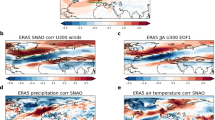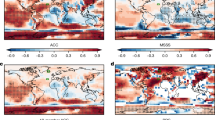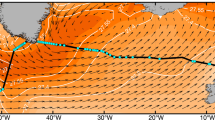Abstract
The winter North Atlantic Oscillation is the primary mode of atmospheric variability in the North Atlantic region and has a profound influence on European and North American winter climate. Until recently, seasonal variability of the North Atlantic Oscillation was thought to be largely driven by chaotic and inherently unpredictable processes1,2. However, latest generation seasonal forecasting systems have demonstrated significant skill in predicting the North Atlantic Oscillation when initialized a month before the onset of winter3,4,5. Here we extend skilful dynamical model predictions to more than a year ahead. The skill increases greatly with ensemble size due to a spuriously small signal-to-noise ratio in the model, and consequently larger ensembles are projected to further increase the skill in predicting the North Atlantic Oscillation. We identify two sources of skill for second-winter forecasts of the North Atlantic Oscillation: climate variability in the tropical Pacific region and predictable effects of solar forcing on the stratospheric polar vortex strength. We also identify model biases in Arctic sea ice that, if reduced, may further increase skill. Our results open possibilities for a range of new climate services, including for the transport6,7, energy, water management8 and insurance sectors.
This is a preview of subscription content, access via your institution
Access options
Subscribe to this journal
Receive 12 print issues and online access
$259.00 per year
only $21.58 per issue
Buy this article
- Purchase on Springer Link
- Instant access to full article PDF
Prices may be subject to local taxes which are calculated during checkout




Similar content being viewed by others
References
Johansson, A. Prediction skill of the NAO and PNA from daily to seasonal time scales. J. Clim. 20, 1957–1975 (2007).
Kim, H.-M., Webster, P. & Curry, J. Seasonal prediction skill of ECMWF System 4 and NCEP CFSv2 retrospective forecast for the Northern Hemisphere winter. Clim. Dynam. 23, 2957–2973 (2012).
Scaife, A. A. et al. Skillful long-range prediction of European and North American winters. Geophys. Res. Lett. 41, 2514–2519 (2014).
Riddle, E. E., Butler, A. H., Furtado, J. C., Cohen, J. L. & Kumar, K. CFSv2 ensemble prediction of the wintertime Arctic Oscillation. Clim. Dynam. 41, 1099–1116 (2013).
Stockdale, T. N., Molenti, F. & Ferranti, L. Atmospheric initial conditions and the predictability of the Arctic Oscillation. Geophys. Res. Lett. 42, 1173–1179 (2015).
Palin, E. et al. Skilful seasonal forecasts of winter disruption to the UK transport system. J. Appl. Meteorol. Clim. 55, 325–344 (2016).
Karpechko, A. Y., Peterson, K. A., Scaife, A. A., Vainio, J. & Gregow, H. Skilful seasonal predictions of Baltic Sea ice cover. Environ. Res. Lett. 10, 044007 (2015).
Svensson, C. et al. Long-range forecasts of UK winter hydrology. Environ. Res. Lett. 10, 064006 (2015).
Athanasiadis, P. J. et al. The representation of atmospheric blocking and the associated low-frequency variability in two seasonal prediction systems. J. Clim. 27, 9082–9100 (2014).
Sun, J. & Ahn, J.-B. Dynamical seasonal predictability of the Arctic Oscillation using a CGCM. Int. J. Climatol. 35, 1342–1353 (2015).
Kang, D. et al. Prediction of the Arctic Oscillation in boreal winter by dynamical seasonal forecasting systems. Geophys. Res. Lett. 41, 3577–3585 (2014).
Eade, R. et al. Do seasonal-to-decadal climate predictions underestimate the predictability of the real world? Geophys. Res. Lett. 41, 5620–5628 (2014).
Siegert, S. et al. A Bayesian framework for verification and recalibration of ensemble forecasts: how uncertain is NAO predictability? J. Clim. 29, 995–1012 (2016).
MacLachlan, C. et al. Global seasonal forecast system version 5 (GloSea5): a high-resolution seasonal forecast system. Q. J. R. Meteorol. Soc. 141, 1072–1084 (2015).
Murphy, J. M. Assessment of the practical utility of extended range ensemble forecasts. Q. J. R. Meteorol. Soc. 116, 89–125 (1990).
Shi, W., Schaller, N., MacLeod, D., Palmer, T. N. & Weisheimer, A. Impact of hindcast length on estimates of seasonal climate predictability. Geophys. Res. Lett. 42, L1554 (2015).
Brönnimann, S., Xoplaki, E., Casty, C., Pauling, A. & Luterbacher, J. ENSO influence on Europe during the last centuries. Clim. Dynam. 28, 181–197 (2007).
Bell, C. J., Gray, L. J., Charlton-Perez, A. J., Joshi, M. & Scaife, A. A. Stratospheric communication of El Niño teleconnections to European winter. J. Clim. 22, 4083–4096 (2009).
Ineson, S. & Scaife, A. A. The role of the stratosphere in the European climate response to El Niño. Nat. Geosci. 2, 32–36 (2009).
Rodwell, M. J., Rowell, D. P. & Folland, C. K. Oceanic forcing of the wintertime North Atlantic Oscillation and European climate. Nature 398, 320–323 (1999).
Yang, S. & Christensen, J. H. Arctic sea ice reduction and European cold winters in CMIP5 climate change experiments. Geophys. Res. Lett. 39, L20707 (2012).
Kidston, J. et al. Stratospheric influence on tropospheric jet streams, storm tracks and surface weather. Nat. Geosci. 8, 433–330 (2015).
Luo, J.-J., Masson, S., Behera, S. K. & Yamagata, T. Extended ENSO predictions using a fully coupled ocean–atmosphere model. J. Clim. 21, 84–93 (2008).
Kodera, K. & Kuroda, Y. Dynamical response to the solar cycle. J. Geophys. Res. 107, 4749 (2002).
Ineson, S. et al. Solar forcing of winter climate variability in the Northern Hemisphere. Nat. Geosci. 4, 753–757 (2011).
Williams, K. et al. The Met office global coupled model 2.0 (GC2) configuration. Geosci. Model Dev. 88, 1509–1524 (2015).
Knight, J. F. et al. Predictions of climate several years ahead using an improved decadal prediction system. J. Clim. 27, 7550–7567 (2014).
Smith, D. M. & Murphy, J. M. An objective ocean temperature and salinity analysis using covariances from a global climate model. J. Geophys. Res. 112, C02022 (2007).
Rayner, N. A. et al. Global analyses of sea surface temperature, sea ice, and night marine air temperature since the late nineteenth century. J. Geophys. Res. 108, 4407 (2003).
Dee, D. P. et al. The ERA-Interim reanalysis: configuration and performance of the data assimilation system. Q. J. R. Meteorol. Soc. 137, 553–507 (2011).
Taylor, K. E., Stouffer, R. J. & Meehl, G. A. An overview of CMIP5 and the experiment design. Bull. Am. Meteorol. Soc. 93, 485–498 (2012).
Acknowledgements
This work was supported by the Joint DECC/Defra Met Office Hadley Centre Climate Programme (GA01101), the EU FP7 SPECS project and the UK-China Research & Innovation Partnership Fund through the Met Office Climate Science for Service Partnership (CSSP) China as part of the Newton Fund.
Author information
Authors and Affiliations
Contributions
N.D. led the analysis. N.D., D.S. and A.S. wrote the paper with comments from all other authors.
Corresponding author
Ethics declarations
Competing interests
The authors declare no competing financial interests.
Supplementary information
Supplementary Information
Supplementary Information (PDF 1087 kb)
Rights and permissions
About this article
Cite this article
Dunstone, N., Smith, D., Scaife, A. et al. Skilful predictions of the winter North Atlantic Oscillation one year ahead. Nature Geosci 9, 809–814 (2016). https://doi.org/10.1038/ngeo2824
Received:
Accepted:
Published:
Issue Date:
DOI: https://doi.org/10.1038/ngeo2824
This article is cited by
-
Seasonal forecasting of subsurface marine heatwaves
Communications Earth & Environment (2023)
-
Windows of opportunity for predicting seasonal climate extremes highlighted by the Pakistan floods of 2022
Nature Communications (2023)
-
Reduced Southern Ocean warming enhances global skill and signal-to-noise in an eddy-resolving decadal prediction system
npj Climate and Atmospheric Science (2023)
-
Skilful predictions of the Summer North Atlantic Oscillation
Communications Earth & Environment (2023)
-
Skilful Forecasts of Summer Rainfall in the Yangtze River Basin from November
Advances in Atmospheric Sciences (2023)



